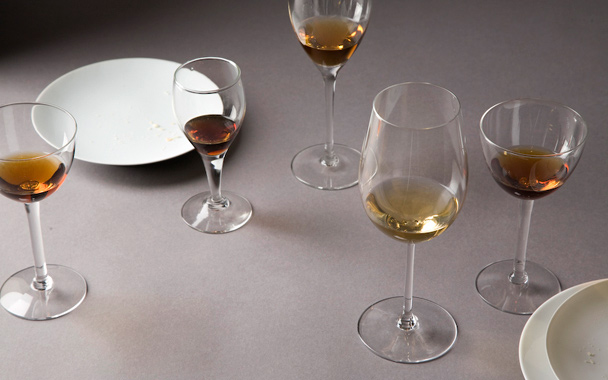I haven’t drunk anything but Sherry for the last week. Even stranger, I’m not missing regular wine. Some of that is because I’m in Jerez de la Frontera, the southern Spanish town in which Sherry is made. (Sherry takes its name from Jerez, which used to be called Sherrish in Arabic.) But not because it’s balmy and the sea breezes put me in the mood for a cold, crisp white with the tang of the sea—it’s actually about 40°F, which, in combination with the heavy humidity of a town barely above sea level (and a lack of central heating), is absolutely, bone-numbingly freezing.
Instead, I’m drinking it because it seems to match just about anything. Take, for instance, the artichokes served at Bar Juanito, a restaurant here that specializes in them. Cooked until tender and pungently artichoke-y in an herbal broth, these thistles would make most wines taste as sweet as Riunite. A Fino Sherry, however, tastes just dry instead of bone-dry, as it does on its own.
Then there are the sweetbreads, cut into small pieces and pan-fried until golden, and a thick stew of chickpeas, white beans, morcilla, chorizo, and small chunks of fatty pork—red wine dishes for certain, I thought. But the Fino slices through the sweetbreads like a knife, its saltiness playing up the sweetness of their caramelized surfaces, its acidity cutting the richness. With the stew, the Fino’s acidity goes after the fatty chunks of meat like a heat-seeking missile. The play of acid against richness is totally addictive.
Of course, the people of Jerez have long known this—Sherry is simply what you drink when you’re not having a cold Cruzcampo—and so, to prove it, the Sherry Council of America organized the Copa Jerez, an international competition for chefs and sommeliers to come up with the most intriguing Sherry-and-food matches. On the Thursday morning of the competition, in a small culinary school in an industrial park on the outskirts of Jerez, a 24-year-old British Army cook—sharply dressed in a red cap and matching apron—is whipping up venison with juniper berries to match her colleague’s Oloroso Dulce Sherry, while a jean-clad Catalan couple from Embat in Barcelona prepare scallops and park jowl to pair with a Manzanilla. The Belgian team is fuming, having had to bow out of the competition after Iberia Airlines lost the luggage holding their knives and ingredients; the Danish chef is making dessert out of Sherry-barrel sawdust and Pedro Ximénez bubbles to go with a sweet PX Sherry.
Things get even weirder when the Dutch sommelier from de Lindenhof whips out a decanter with a neck nearly two feet long that she lugged here along with glassware. Decant a Sherry? The American sommelier, Roger Kugler, stares, wondering if he’s under-prepared for the event, as his partner, Seamus Mullen of NYC’s Boqueria and Suba, grates almonds one by one on a Microplane to shower over his sheep’s milk flan.
The degree of worry ratchets up across the board as plates and glasses land in front of the judging panel: Juli Soler, Ferran Adrià’s partner at El Bulli, can’t sit still long enough to make it through any of the chefs’ and sommeliers’ presentations, drumming on the table and calling for cigarette breaks; Kazuyoshi Kogai, the president of the Japanese sommelier association, has a face so stony it’s a wonder he can open his mouth wide enough to get any food in. When the chef and sommelier finish presenting their pairing to the judges, the chef runs back to the kitchen to prepare the next course while the sommelier rushes upstairs to repeat everything to a room of journalists and photographers armed with sharp forks. It’s a wonder there are no injuries.
In the end, the Dutch take the prize for the “Ultimate Food & Sherry Menu” (although Kugler wins “Top Sommelier” for his warm delivery and thoughtful explanations, no fancy glassware required). It was my least favorite menu—“glazed veal sweetbreads wrapped in a crunchy coffee torte with caramelized cauliflower purée, small sugar beets, rice chips and sushi-ginger foam” preceded the course featuring the powdered wine barrel—but it doesn’t really matter. Tasting each team’s dishes alongside their particular Sherries, I’m impressed in exactly the way the competition intended: Sherry really can match nearly everything, light, heavy, salty or sweet, depending on style.
Yet I can’t stop thinking about Bar Juanito, and I’m already dreaming of dinner tonight, someplace where little fish are served like French fries and the ham comes unadorned—all the better to taste the seaside captured in a copa of Sherry.



 Pinterest
Pinterest


